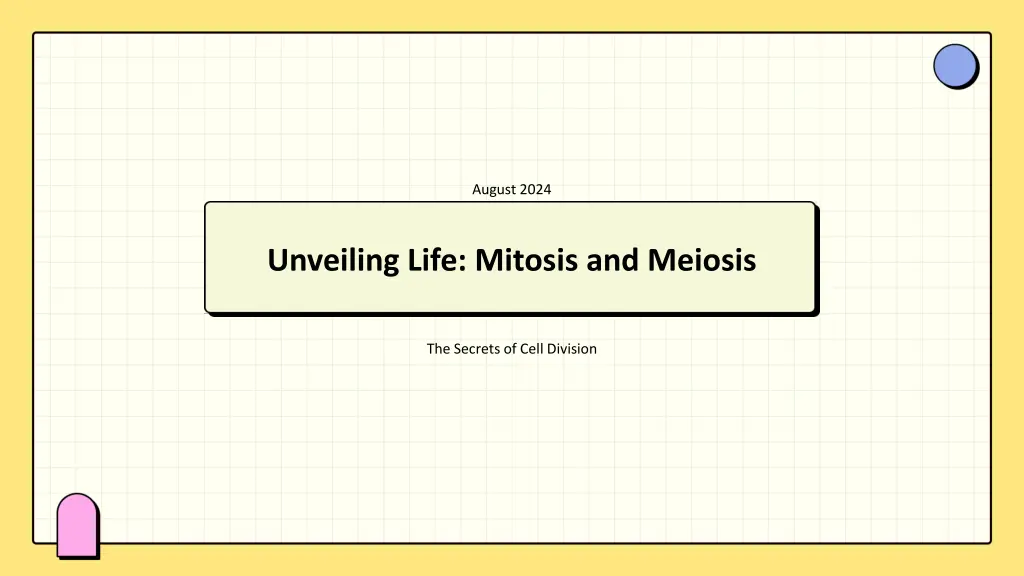
Unlocking the Mysteries of Mitosis and Meiosis in Cell Division
Explore the fascinating world of cell division through the processes of mitosis and meiosis, essential for growth, repair, and genetic diversity. Delve into the key differences, learn about the role of DNA, and discover the applications in medicine and education.
Download Presentation

Please find below an Image/Link to download the presentation.
The content on the website is provided AS IS for your information and personal use only. It may not be sold, licensed, or shared on other websites without obtaining consent from the author. If you encounter any issues during the download, it is possible that the publisher has removed the file from their server.
You are allowed to download the files provided on this website for personal or commercial use, subject to the condition that they are used lawfully. All files are the property of their respective owners.
The content on the website is provided AS IS for your information and personal use only. It may not be sold, licensed, or shared on other websites without obtaining consent from the author.
E N D
Presentation Transcript
August 2024 Unveiling Life: Mitosis and Meiosis The Secrets of Cell Division
Table of Contents 5 The Role of DNA 1 The Power of Division 6 Errors in Cell Division 2 Mitosis Explained Meiosis Unraveled 7 Applications in Medicine 3 Key Differences 8 In Education and Research 4
9 Future Perspectives 10 Thank You!
The Power of Division 1. Mitosis and meiosis are processes vital for life, allowing growth, repair, and reproduction in organisms. 2. Mitosis produces two identical daughter cells, ensuring the continuity of genetic information across generations. 3. Meiosis, on the other hand, creates gametes with half the genetic material, enabling genetic diversity and evolution. 4. Understanding these processes helps unlock the Photo by Pexels mysteries of life and informs advancements in medicine and genetics.
Mitosis Explained 1. Mitosis occurs in somatic cells and is structured in distinct distinct phases: prophase, metaphase, anaphase, and and telophase. 2. During prophase, chromatin condenses into chromosomes, and the nuclear envelope breaks down to prepare for division. 3. In metaphase, chromosomes align at the cell's equatorial plane, ensuring accurate separation during the next Photo by Pexels phase. 4. Anaphase follows where sister chromatids are pulled apart, leading to two genetically identical cells at the end of telophase.
Meiosis Unraveled 1. Meiosis occurs in germ cells and consists of two rounds of rounds of division: meiosis I and meiosis II, each with with distinct phases. 2. Meiosis I reduces the chromosome number by half, separating homologous chromosomes to create diversity. 3. Meiosis II resembles mitosis, where sister chromatids are finally separated, leading to four unique haploid cells. Photo by Pexels 4. This process is essential for sexual reproduction, contributing to genetic variation among offspring.
Key Differences 1. Mitosis results in two identical diploid cells, while meiosis meiosis culminates in four genetically diverse haploid haploid cells. 2. Mitosis is crucial for growth and repair, whereas meiosis is essential for sexual reproduction and genetic diversity. 3. Mitosis involves one cell division, while meiosis consists of two sequential divisions, enhancing genetic variation dramatically. Photo by Pexels 4. Recognizing these differences deepens our understanding of life s complexity and the importance of cell processes.
The Role of DNA 1. Both mitosis and meiosis are tightly regulated by DNA, DNA, the hereditary material carrying genetic instructions instructions for life. 2. The replication of DNA ensures that each daughter cell receives an accurate copy, maintaining the organism's traits. 3. In meiosis, crossing over during prophase I allows for genetic recombination, enhancing diversity in traits. Photo by Pexels 4. Understanding DNA's role informs practices in biotechnology, genetics, and medicine, shaping our future.
Errors in Cell Division 1. While essential, errors in mitosis or meiosis can lead to lead to serious consequences like cancer or genetic genetic disorders. 2. For instance, nondisjunction in meiosis can cause conditions like Down syndrome due to an extra chromosome. 3. Awareness of these errors drives research into cancer treatments and genetic counseling, improving health Photo by Pexels outcomes. 4. Addressing these challenges opens up new avenues for advancements in science and medicine.
Applications in Medicine 1. Understanding mitosis and meiosis is crucial in developing therapies for diseases, especially those those related to cell division. 2. Cancer treatments often target rapidly dividing cells, highlighting the importance of controlling mitotic pathways. 3. Gene therapy techniques utilize principles of meiosis to correct genetic disorders and develop personalized Photo by Pexels medicine. 4. Harnessing this knowledge can revolutionize the healthcare landscape, enhancing lives worldwide.
In Education and Research 1. Mitosis and meiosis are fundamental concepts in biology biology education, sparking interest in life sciences sciences among students. 2. Research in cell division fosters innovation in various fields, from agriculture to environmental science. 3. Understanding these processes promotes critical thinking, encouraging the next generation of scientists to explore and innovate. Photo by Pexels 4. Educational initiatives focusing on cell division cultivate informed citizens and inspire future leaders.
Future Perspectives 1. As science advances, our understanding of mitosis and and meiosis will continue to evolve, revealing new insights. 2. Innovations in microscopy and genetic engineering will enhance our ability to observe and manipulate these processes. 3. Exploring cell division may unlock solutions to pressing global challenges, from health crises to climate change. Photo by Pexels 4. The future of biology is bright, with endless possibilities for discovery and application in everyday life.
Thank You! 1. Thank you for joining us on this journey into the fascinating world of cell division! 2. Remember, every cell is a building block of life, playing a crucial role in our existence. 3. Stay curious about the science around you and keep exploring the wonders of biology. 4. Together, we can unlock new chapters in the story of life. Photo by Pexels
